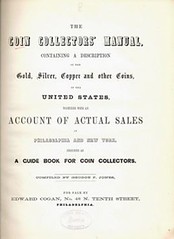
PREV ARTICLE
NEXT ARTICLE
FULL ISSUE
PREV FULL ISSUE
COIN COLLECTOR’S MANUAL: FIRST U.S. PRICE GUIDE
In his November 2, 2015 Numismatic Bookie column for Coin World, Joel Orosz examines the first "Guide Book for Coin
Collectors", published in 1860. -Editor
Coin collecting in America is older than the nation: numismatists were prowling the colonies by the 1750s. There were few “coin cranks” at first, but their numbers steadily increased. The hobby grew exponentially during the 1850s, but new collectors were flying blind: there were no reference books, no numismatic newspapers, no coin clubs, and few part-time dealers. Enter the ingenious George F. Jones, with The Coin Collector’s Manual, which he stated was “Designed as a guide book for coin collectors.” How could Jones determine a coin’s value in the small market of 1860? He resourcefully discovered five guides from the recent past: the auction of John W. Kline’s collection in June 1855; Edward Cogan’s sale of his large cents in November 1858; Cogan’s auction of J.N.T. Levick’s collection in December 1859; Augustus B. Sage’s and Bangs, Merwin’s auctions in 1859; and Cogan’s sale of May 1860. For these events (all except Sage’s and Bangs’ held in Philadelphia), Jones recorded the coin’s price realized, and its condition. So, for each listed piece — say, a 1796 Draped Bust dollar — there were up to five values provided from auction sales. These coins tended to be in varying conditions, which led to some curious comparisons. A 1799 Draped Bust cent in Fine condition, for example, had gone for $8 at the Levick Sale in 1859, but another only in Good went for $10 at Cogan’s sale just a year later. In explanation of such anomalies — proving that some things never change — Jones writes: “There are some apparent discrepancies where the condition of the coin sold, is represented as the same, [but] the prices are widely different. This can be accounted for in no other way, than that one coin collector or dealer may call a coin fine or very fine, when another would describe one exactly like it, only as good or fine.” Another of Jones’ observations also reinforces the constancy of some numismatic maxims: “Coins in poor condition, unless decidedly rare, are receiving but little notice, while those which are good impressions, find liberal purchasers immediately.” But some things do change, including numismatic nomenclature. Jones calls the 1793 chain cent a “link;” he lists a 1795 “Curious head” cent; and Jones calls the 1856 flying eagle cent a “buzzard.” The Coin Collector’s Manual was published in a small edition, and is today quite rare. It was the Red Book decades before there was a Red Book, and humble though it was, opened the door to literally millions of guide books to follow. To read the complete article, see:

Wayne Homren, Editor The Numismatic Bibliomania Society is a non-profit organization promoting numismatic literature. See our web site at coinbooks.org. To submit items for publication in The E-Sylum, write to the Editor at this address: whomren@gmail.com To subscribe go to: https://my.binhost.com/lists/listinfo/esylum All Rights Reserved. NBS Home Page Contact the NBS webmaster 
|
